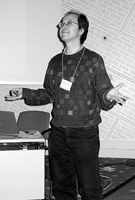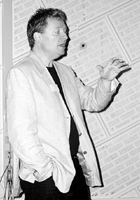UKIE Applied/Computational Mathematicians Greet the Year in Sheffield, Manchester
May 25, 2004

After wrapping up the annual meeting of the SIAM UKIE Section with a talk on self-adaptive software, Jack Dongarra joined the subset of participants who went on to Manchester for a weekend workshop, New Frontiers in Computational Mathematics. His Frontiers topic: grid computing.
Ivan Graham and Nicholas J. Higham
The SIAM United Kingdom and Republic of Ireland Section held its 2004 Annual Meeting at the University of Sheffield on Friday, January 9, 2004. The meeting was followed by a weekend workshop, New Frontiers in Computational Mathematics, 38 miles away at the Chancellors Hotel and Conference Centre, University of Manchester. Coincidentally, both meetings had 63 participants, and a number of people took advantage of the juxtaposition to attend both.
After opening remarks by Martin Stynes (Cork), president of the SIAM UKIE Section, David Thomson (UK Met Office) began the technical part of the Sheffield program with a talk on Monte Carlo methods for modelling atmospheric flows and dispersion. Although most commonly occurring flows are characterised as deterministic, Thomson showed that they often possess a genuinely stochastic character. He presented various cases in which stochastic subgrid modelling can be used to enhance standard deterministic codes, referring as an example to the problems of weather and climate prediction.
Lucy Wyatt (University of Sheffield) followed with a talk on inverse methods for ocean surface measurements made with HF radar. She presented examples of various configurations of the radar transmitters and receivers used to measure wave characteristics at distant points on the ocean surface in real time. She then described the mathematical basis of the measurements, which involves the solution of a nonlinear ill-posed integral equation using band-limited radial basis function approximations as part of a regularised iterative method.
Participants returned from lunch to a talk on the mathematics of the human eye. Alastair Fitt (University of Southampton) described simple mathematical models developed to understand how eyes work. Using techniques from fluid and solid mechanics, and various analytic and asymptotic solution methods, he had found solutions to various modelling problems, including the growth of hyphema, use of the Imbert-Fick principle for measuring intraocular pressure, and investigation of the purpose of REM sleep. His discussion of the Imbert-Fick principle was accompanied by hair-raising pictures of eye surgery.
In a talk on algebraic aspects of coding theory, Pat Fitzpatrick (University College Cork) explained how error-correcting codes are essential to the extraction of signal from noise in modern digital communication media, including mobile phones, CDs, and DVDs. He went on to give the audience a crash course in the algebra of finite fields and explained various efficient decoding algorithms, in particular the class of alternant codes in which decoding involves computing a Pad� approximant over a finite field. He finished with a call for an increase in the algebra content of undergraduate engineering curricula.
Jack Dongarra (University of Tennessee/ORNL) closed the Sheffield program with a talk on self-adapting numerical software, and opened the New Frontiers workshop the following day. We will soon have laptops that can achieve teraflop/s speeds, he pointed out in Sheffield, but our ability to achieve theoretical peak speeds for floating-point-intensive computations is still limited by our ability to adapt algorithms to the given memory hierarchy. Self-adaptive software is designed to provide the user with automatic procedures for producing optimised code for any given machine. Dongarra's examples of recent implementations of this philosophy included LFC (LAPACK for Clusters). In the relatively near future, he said, users can expect to be able to program in a language like MATLAB and have their code automatically optimised and run on specialised machines, such as a cluster.
The meeting finished with a vote of thanks for the local organising team, headed by Philip Chatwin. The SIAM UKIE Section is going from strength to strength, its membership having expanded from 187 in 1996 to 279 today. The next annual meeting, provisionally scheduled for January 7, 2005, will be held at University College Cork in the Republic of Ireland.
***
The program for the New Frontiers weekend workshop focused on four cutting-edge, interdisciplinary research areas in computational mathematics, with a keynote speaker in each, along with contributed talks and posters. Just the briefest highlights are reported here. For more details, see the conference Web site (http://www.maths.man.ac.uk/MCCM/frontiers.html), which contains photographs and links to many of the presentations.
The workshop was organized by Nick Higham, Tony Shardlow, and Fran�oise Tisseur (University of Manchester) and David Silvester (University of Manchester Institute of Science and Technology) under the auspices of the Manchester Centre for Computational Mathematics, with financial support from the University of Manchester, the London Mathematical Society, the SIAM UK and Republic of Ireland Section, the Royal Society, and the Wolfson Foundation.
In the opening talk, "Trends in High Performance Computing and the Grid," Jack Dongarra described the evolution of computational power and the way it is measured, before turning to how the power is being exploited in computational settings ranging from grid computing to Google. Mikel Lujan (University of Manchester) described how the OoLaLa project is using object technology in the design of high-performance linear algebra libraries in order to reduce the number of specialized interfaces, and hence the coding effort, while having minimal impact on performance. Len Freeman (University of Manchester) described a feedback-guided parallel loop scheduling algorithm that was motivated by a collaboration with the UK Meteorological Office.
Mark Chaplain (University of Dundee) opened a diverse session on mathematical biology. After a survey of the modelling of cancer cells, he focused on one of his particular interests, angiogenesis, with a description of the evolution of networks of blood vessels in tumours. Of interest both for the mathematics and for the insight into the workings of our bodies, this session also offered talks by Andrew Hazel (University of Manchester), who presented a computational study of airway closure (one of the conclusions: keep breathing!); Andrew Wathen (Oxford University), who described computational models of pattern formation on butterfly wings; and urologist C.P. Arun (University College, London), who reported on work in the little studied area "mathematical modelling of micturation." Arun gets the award for the most striking title: "Bladder contraction is rocket science!"
Per Christian Hansen (Technical University of Denmark) led off in a session on inverse problems and ill-posed problems with a talk titled "Large-Scale Methods for Linear Inverse Problems." Via numerous practical examples, he emphasised the importance of regularisation and the advantages of exploiting structure in large-scale problems. In the same session, Bill Lionheart (UMIST) discussed inverse problems in electromagnetics, including electrical impedance tomography in medical diagnosis, and described a number of interesting PDE and optimization problems that arise.
The final session, on image processing and computer vision, began with a discussion of PDE methods by Tony Chan (UCLA). He treated, among many other things, the "inpainting" problem-the filling in of an occluded subject in an image, of interest to anyone whose thumb tends to get in front of the camera lens. Ke Chen (Liverpool) discussed multigrid techniques for solving PDEs that arise in imaging. Stephen Marsland (University of Manchester) explained the advantages of using diffeomorphisms in image registration, illustrating with the geodesic clamped spline and examples drawn from brain scans.
A notable feature of the meeting was the high standard of the 18 posters, which were professionally produced and very readable.
Overlapping with this meeting was a day-and-a-half workshop held at Stanford University, January 9 and 10, to celebrate the 60th birthdays of three numerical analysts: Jim Varah, Alan George, and Michael Saunders. Gene Golub (Stanford), Michael Friedlander (Argonne National Laboratory), Chen Greif (University of British Columbia), and Esmond Ng (Lawrence Berkeley National Laboratory) were the organizers of the event. Attendees at the New Frontiers meeting faxed greetings and best wishes for many more productive years to the Stanford honorees.
In concluding remarks, David Silvester pointed out that the New Frontiers workshop had delimited the frontiers of knowledge in the four areas of computational mathematics considered-an ample result for a weekend meeting-and expressed the hope that a future, more lengthy Manchester workshop would extend the boundaries.
Ivan Graham is a professor of numerical analysis at the University of Bath. Nicholas J. Higham is the Richardson Professor of Applied Mathematics at the University of Manchester.

Speaking in a session on image processing and computer vision, Tony Chan devoted a portion of his talk to inpainting, the filling in of occluded objects in images.

In a session devoted to inverse and ill-posed problems at the Frontiers workshop, Per Christian Hansen discussed large-scale methods for linear inverse problems.

Andrew Wathen, a participant in a diverse session on mathematical biology at the Frontiers workshop, described computational models of the formation of patterns on butterfly wings.

